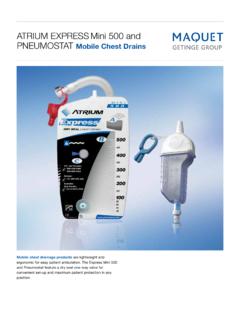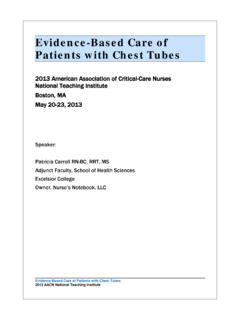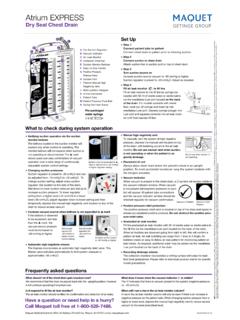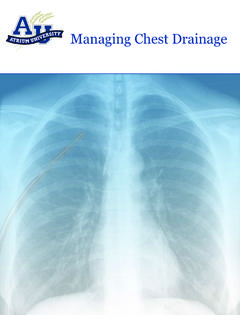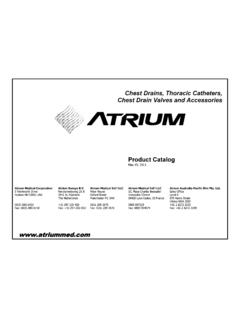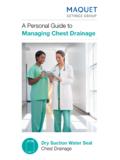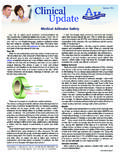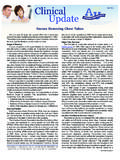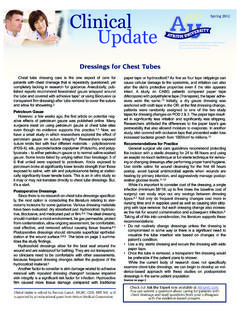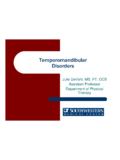Transcription of Big Data and Nursing Practice: Essential Tool or Overload?
1 Big data is the buzzword describing massive data sets that require special processing to provide useful information. It has been used to analyze voter characteristics and predict elections; to examine patterns of crime in different communities by comparing to demographics such as income, education, and housing type; and in a variety of healthcare applications, such as investigating patterns of childhood vaccination to determine if there are correlations to religious preference, public or private school, parents education, and even the supermarket at which they shop.
2 Scans social media for evidence of illness and maps it, much like weather radar. In 2012-2013, Sickweather picked up the early flu season about six weeks before CDC. There is, typically, a two-week lag between what health care professionals see in real-time and the CDC s While data analyses provide useful information that can guide practice, the 21st century has given us another concept information overload. Where is the line between useful and overwhelming?Nurses do the Work The first legislation to support health information tech-nology passed ten years ago.
3 Since then, with significant changes to Medicare and Medicaid reimbursement and the Affordable Care Act, electronic medical records (EMR) are standard. The majority of documentation comes from nurses whether through checklists, narrative notes or scanned data . The quality of this data capture is critical for it deter-mines both reimbursement rates and public reporting scores. If the EMR does not accurately capture Nursing care quality, the hospital will suffer financially. This is the leverage nurses can use to insist on a seat at the table when hospitals choose or modify EMR systems, when workflow changes are required.
4 And to discuss how hardware and software support or impede bedside Role in Clinical data Analysis The QSEN project quality and safety education for nurses began with a grant in 2006 to prepare nurses to continually improve the quality and safety of the healthcare systems in which they QSEN competencies include using data to monitor outcomes, making changes to care processes that improve quality and safety, and using infor-matics to improve care. Thus, nurses have a professional responsibility to not just accept the quality monitoring the EMR vendor offers (dashboards and report cards) but to think about the needs of their patient population and identify areas where data monitoring can help improve outcomes.
5 For example, there is no point in tracking patient falls or catheter-associated urinary tract infections in a neonatal ICU, but they may be the two key indicators for an inpatient geriatric unit. The tricky part is linking data to outcomes. Many dash-boards or report cards track whether patients are assessed for risk for impaired skin integrity or fall risk. While those assessments are necessary, they are not contributing to patient safety or quality care if they do not drive Nursing care.
6 The key metric is whether an assessment indicating risk then changes the plan of care to include risk reduction strategies and if they prevent the fall or skin damage. That s how to close the circle that opens with the initial assessment. If a patient does fall, for example, the RN should imme-diately huddle with the care team for a quick cause analysis: Did the patient s condition change since the assessment, requiring different precautions? Were the precautions appro-priate, but not followed? If not followed, is there a lack of understanding or a system problem that prevented proper care such as insufficient staffing?
7 Rather than waiting for a monthly meeting, or leaving it to the risk manager, this instant analysis by the people providing the hands-on care can distil actionable data that can change the care plan on the Is It Too Much? In these cases, data analysis and information manage-ment have a direct link to improving patient care in real-time. But what happens when you re overwhelmed with information and your work is regularly interrupted by new bits of random information on patients while you are trying to document care or pass meds?
8 She can have visitors now. His labs just came back. He needs to go to the bathroom. Where s Dr. X? She wants pain meds. He s not responding!!! And, of course, there s alarm fatigue like the boy who cried wolf, we natu-rally become insensitive to those repeated alerts for technical issues unrelated to the patient s condition. The Cognitive Work of Nursing Framework (CWNF) has been developed to address how nurses consider the rate and volume of information presented to The framework includes work complexity, clinical reasoning, cognitive stack-ing, clinical judgment, and Nursing care delivery.
9 Cognitive stacking is a method of prioritizing the decision-making nurses do on a minute-by-minute basis as they constantly rearrange tasks in their mind. The authors note this framework addresses the invis-ible part of Nursing practice the part that non-nurses can t comprehend. This is the critical aspect of practice that is significantly affected by experience. As Benner s work taught us, the novice nurse is characterized by treating each piece of data as an individual point with equal weight while the expert nurse typically does not even note discrete data Big data and Nursing Practice: Essential Tool or Overload?
10 Clinical Update is edited by Patricia Carroll, MS, RN-BC, CEN, RRT, and supported by an educational grant from Atrium Medical on page 3 Fall 2015 You can now earn contact hours for reading Clinical Update! Click here or go to for the LiteratureReviewing Fluid Splashes and SplattersThe current issue of American Nurse Today includes a report from the Exposure Prevention Information Network (EPINet) covering the most recent five-year period for which data are available, 2009-2013. EPINet tracks blood and body fluid exposures occurring in hospital work-ers, allowing hospitals to benchmark their exposure data .
